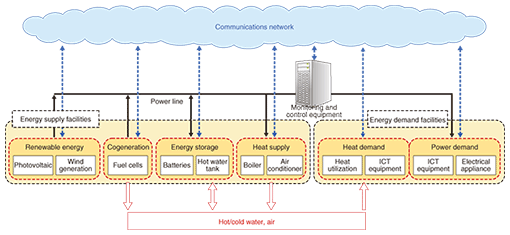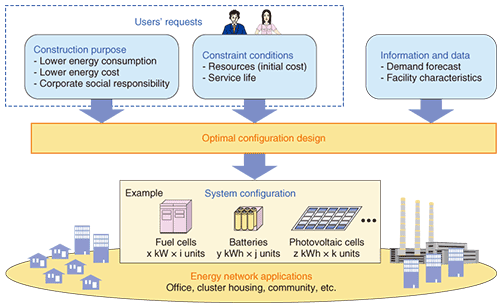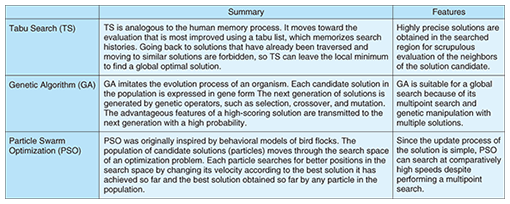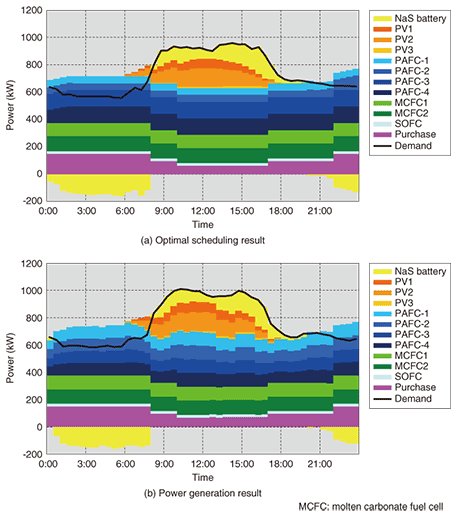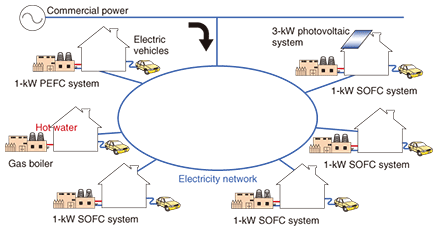 |
|||||
|
|
|||||
|
Feature Articles: Environment and Energy Technologies Toward a Green Society Vol. 9, No. 2, pp. 25–30, Feb. 2011. https://doi.org/10.53829/ntr201102fa4 Energy Network Optimization TechnologyAbstractEnergy network optimization technology achieves operational control and system construction for purposes such as reducing the environmental load by efficiently matching energy demand and supply from numerous facilities. This article describes demonstrative optimal scheduling research and a system configuration simulation as applications of this technology.
1. IntroductionInterest in reducing CO2 emissions and using energy efficiently has increased recently, and the technology for achieving these goals has become important. An energy network is a system that utilizes energy effectively by controlling a large number of energy supply and demand facilities of various types by using a communication network.
2. Optimal controlEnergy supply and demand facilities must be operated with consideration given to their characteristics. This will sufficiently demonstrate effects such as economic efficiency and the environmental impact of an energy network with various facilities. An example of an energy control flow chart is shown in Fig. 2. Projected temperature and weather conditions for the next day are obtained from a weather forecast. This information is then combined with past performance data to estimate the amount of electricity and heat available as natural energy generation sources and also estimate the demand for electricity and heat. These estimates are then used to determine the optimal scheduling that will minimize CO2 emissions or energy costs over a one-day or one-week period. The output is an operation plan optimized for the required purpose by considering various energy characteristics and operating constraints. This optimized operating schedule is then used to control the energy system.
3. Optimal configuration designThe configuration of an energy network—types, capacities, and quantities of energy devices—greatly affects the environmental and economic benefits of forming that network at a target site. The actual design of energy devices usually considers reserve power to respond to energy demand growth. However, a huge excess capacity for energy devices may lead to a longer period of partial-load operation, which results in increased energy consumption and operation costs. One must determine a system configuration that can supply energy to meet the demand, which fluctuates seasonally so this imbalance does not occur all year round. In deciding the system configuration, one must consider the construction purpose and constraint conditions, such as initial cost and service life (Fig. 3). Information such as demand forecast and facility characteristic data is used to decide the type and number of facilities that are thought to be suitable to meet the users’ requests.
4. Application of meta-heuristicsOptimal scheduling and configuration design may be formulated as optimization problems that must satisfy constraint conditions, such as the operation constraint of each energy facility. These problems find the best solution, such as minimized CO2 emissions. Mathematical programming for optimization problems requires an inordinate calculation time due to the nonlinear and discontinuous nature of energy facilities, and it can only produce local optimal solutions. Meta-heuristics are uniform methodologies based on heuristics testing for efficiently finding solutions to optimization problems. They can obtain highly accurate approximate solutions to global optimization problems quite quickly regardless of the type of evaluation function or constraints. A wide range of meta-heuristics have been proposed and improved. The algorithms applied to optimize the energy network are listed in Table 1. These algorithms simulate human memory, the evolution process of an organism, and the movement of an organism group. They offer a general-purpose frame that does not depend on the problem. Therefore, various application techniques are possible for optimizing the energy network. These techniques must be adjusted and contrived according to the characteristics of the problem in order to conduct a solution search that is stable regardless of the condition.
5. Demonstrative optimal scheduling researchThe New Energy and Industrial Technology Development Organization (NEDO) commissioned the world’s first trial implementation of a new large-scale energy system at Expo 2005 and at the Central Japan Airport City, both located in Aichi Prefecture, Japan. Demonstrative research on the energy system was conducted. NTT Facilities, Inc. was put in charge of developing the energy control system, and it commissioned us to develop the optimal scheduling programs that applied tabu search and a genetic algorithm. As the demonstrative research advanced from Expo 2005 to Central Japan Airport City, various research subjects, such as increasing the number of control units and extending the optimization period, were tackled, and the algorithms were also improved. Both algorithms were verified to be flexibly applicable for calculating the scheduling under required conditions. An example of our optimal scheduling results and the power generation results are shown in Fig. 4. The power generation plan was calculated for economic efficiency, so the commercial power consumed changed according to the hourly electricity prices. Realtime control throughout a day was carried out on the basis of the power generation plan. Phosphoric acid fuel cells (PAFCs) were operated at the output corrected from the daytime-plan to achieve control in proportion to the PV generation prediction error and the FC model error. Charging and discharging of sodium-sulfur (NaS) batteries and commercial power were conducted almost as planned.
For each season and various demand patterns, such as weekdays and holidays, the optimal scheduling results were continuously calculated automatically for more than a year. The results demonstrated that the pilot implementation met the performance target. 6. System configuration and environmental evaluationTo optimize the system configuration featuring an optimal operating schedule, one must consider nonlinearity due to the characteristics of the energy facilities and logic in operational constraints. Therefore, it is preferable to regard this problem as a mixed integer nonlinear programming problem. We examined system configuration optimization and environmental evaluation by using a method based on particle swarm optimization, which is effective for such problems. As shown in Fig. 5, we assumed a target site consisting of six residences with power and hot water demand to form an energy network. Power is purchased from the commercial grid and/or generated by FC and PV systems to meet the demand, including that of electric vehicles, and assumed to be shared among residences. In addition, hot water is supplied from the FC system and gas boilers to meet the demand.
Either an FC system or a gas boiler is assumed to be installed in each residence. An FC system consists of an FC unit, a hot water tank unit, and a backup boiler. Two choices of FC system were considered in this simulation: a solid oxide fuel cell (SOFC) system, which has high generation efficiency and operates continuously, or a polymer electrolyte fuel cell (PEFC) system, which operates in a daily start-stop mode. In many optimal cases, SOFCs were introduced to most residences, as a result of the optimization simulation for minimizing CO2 emissions. However, a PEFC was introduced instead of an SOFC when the CO2 emission factor was considered independent of day and night. In the residence with low heat demand, an optimum solution was a gas boiler instead of an FC system. Therefore, a two-part CO2 emission factor and a shift in electrical load need to be considered in determining the system design of energy networks. 7. ConclusionSystems in which energy supply and demand are efficiently matched through the use of energy network optimization technology have a wide range of application. In the future, the technology will be improved and expanded for application to complicated systems in which modeling is difficult, such as air flow, and to systems with large-scale controlled targets. Reference
|
|||||








